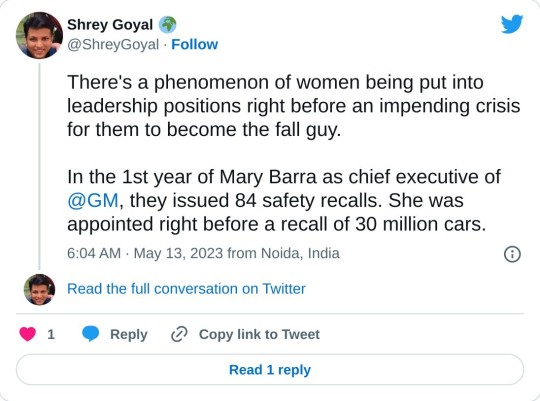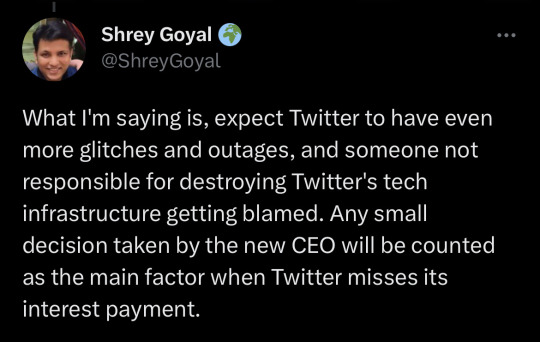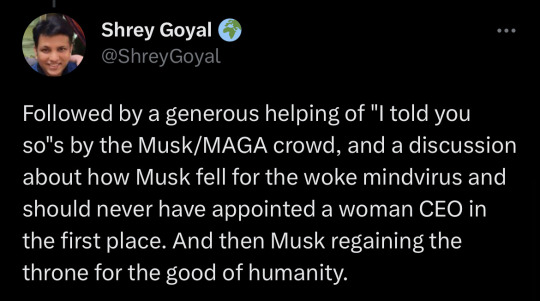#glass ceiling
Text

I have always wanted a black kitchen!
#toya's tales#style#toyastales#black on black#black kitchen cabinets#toyas tales#home decor#interior design#wood flooring#glass ceiling#traditional design#traditional architecture#gothique#gothic#farmhouse sink#kitchen island#traditional kitchen#kitchen storage#kitchen sink#november#fall#autumn#winter#architecture#arch windows#kitchen stuff#kitchen design#kitchen display system#kitchen decor#kitchen
122 notes
·
View notes
Text
This is why accurate information about sex and race is important. A study just gave a name to another way businesses pass over women for promotions and how women of color are impacted at greater rates.
Forget The Glass Ceiling, 'The Broken Rung' Is Why Women Are Denied Promotions
A new study finds Black women and Latinas in particular are the least likely to get that first promotion — and it’s not because they’re not asking for it.
by Monica Torres
Getting your first promotion into management is a huge achievement in your career. But a new study from consulting firm McKinsey & Co. and nonprofit Lean In shows it’s an opportunity that is not equally afforded to everyone.
According to the study, which used pipeline data from 276 companies in the private, public and social sectors, women ― and women of color, in particular ― are the least likely demographic to get promoted from entry-level to first-time manager.
For every 100 men promoted from entry-level contributor to manager in the survey, only 87 women got promoted. And this gap gets wider for women of color: This year, while 91 white women were promoted to manager for every 100 men, only 89 Asian women, 76 Latinas and 54 Black women would get that same opportunity.
“As a result of this broken rung, women fall behind and can’t catch up,” the study states.
It’s not because those women were not asking for it ― the study found that the women were asking for promotions at the same rate as their male peers. And it’s not because these women did not stick around long enough to be considered for the job ― the study found that they were no more likely to leave their company than their male peers.
The main culprit to this “broken rung” in the career ladder? It’s what known as a “performance bias.”
Why women deal with the “broken rung” phenomenon.
Under a performance bias, men get promoted more because of their future potential, while women get judged on their past accomplishments and have their leadership potential doubted.
“Because women early in their careers have shorter track records and similar work experiences relative to their men peers, performance bias can especially disadvantage them at the first promotion to manager,” according to the study.
This research aligns with the “prove-it-again bias” studies have found women face throughout their career: where they do more work in order to be seen as equally competent to their male peers.
As for why it’s hardest for women of color to make that first leap into management? Workplace consultant Minda Harts, author of “The Memo: What Women of Color Need to Know to Secure a Seat at the Table,” said it’s because systemic biases and stereotypes cause women of color to be less trusted for the job.
“This lack of trust can manifest in several ways, such as doubts about competence, commitment or ‘fit’ within a leadership role,” Harts told HuffPost. “When senior leadership is predominantly male and white, an unconscious bias might lead them to trust individuals who mirror their own experiences or backgrounds ... As a result, women of color may be disproportionately overlooked for promotions.”
The McKinsey study found that women of color surveyed this year were even less likely to become first-time managers in 2023 than they were in 2022.
Feminist career coach Cynthia Pong told HuffPost it’s because in tough financial times, companies often operate under a scarcity mindset and might see women of color as a bigger “risk” to promote when they are underrepresented in leadership.
“We just had to go through layoffs, and we only have three [manager roles]. You can easily see how in times like that, it would just end up replicating these systems where we only trust and only give the benefit of the doubt to certain folks,” Pong said. “And it’s not going to be women of color.”
That sends a dispiriting message to people who watch their peers advance while they get told they are still not ready.
“It’s even more frustrating and infuriating ... when you see that there is a pathway for others, but not for you. Because the injustice of it makes your blood boil,” Pong said.
This should not be on women and women of color to fix. Employers should proactively take steps to make a clear promotion path for all.
There is a lot of talk about the “glass ceiling” and the barrier women face that prevents them from becoming executives at the top. But this study illustrates that there is a more fundamental problem happening to women early in their career: the systemic bias that prevents women from being seen as a leader who can manage other people.
“Our success must be something other than a solo sport,” Harts said. “We can’t promote and advance ourselves.”
For companies to be part of the solution, employers should be more transparent about how managerial promotions happen.
“Trust is enhanced when employees understand what is expected of them and what they can expect from their leaders,” Harts said. “This transparency can help mitigate unconscious biases or misconceptions about capabilities or trustworthiness.”
To break down stereotypes and build trust between employees of color and leadership, Harts also recommended companies to implement programs where women of color are paired with sponsors in senior roles.
What you can do about this as an employee.
If you keep being told vague “no’s” after every promotion request, start asking more questions about what your peers are doing that you are not.
“They’re not going to admit to having a systemic problem. They’re going to say, ‘We just don’t have it in the budget,’” said Elaine Lou Cartas, a business and career coach for women of color.
“I’ve seen people that got promoted to this where they are also doing the same amount as I was, but I was doing A, B and C. Help me understand,” is the kind of assertive framing you can use to ask more questions, Cartas said.
And if you find the goalpost of promotion metrics keeps moving after your conversation with your manager, that might be the time to start job hunting.
“Once you already have that conversation, and nothing’s being done, or at least there’s no steps or actions for it to be done in the future, that’s when [you] could start looking,” Cartas said.
Ultimately, one missed promotion may not seem like a huge setback, but it adds up over time with lost wages and earning potential, Pong said.
“And then that also ripples out generationally to all the families and family units that each woman of color is supporting, and then those to come,” she said. “So it seems like it might be like no big deal to have this person promoted one or two years later. But ... these things really snowball.”
#Glass ceiling#Broken rung#Women in the workplace#Women of color in the workplace#For every 100 men promoted only 89 Asian women 76 Latinas and 54 Black women would get that same opportunity#Prove it again bias#The Memo: What Women of Color Need to Know to Secure a Seat at the Table#Minda Hart's
89 notes
·
View notes
Text
youtube
#trans rights#trans#lgbt#furry#politics#autism#nuerodivergent#discrimination#transphobia#covid#police brutality#defund the police#dei#diversity equity and inclusion#racism#glass ceiling#us politics#slavery#american history#youtube#video essay#womens rights#jim crow laws#climate change#global warming#environment#fossil fuels#climate crisis#science#conservatives
3 notes
·
View notes
Text
Barbie: An Essay
Introduction:
Having watched Barbie, directed by Greta Gerwig and staring Margot Robbie and Ryan Gosling, which was released in Cinemas 21st July 2023, although enjoyed initially, it became apparent that it contained very damaging views and messages regarding social structure and social norms which many in the audience may have misinterpreted as cheap jokes. In this essay, we shall discuss and evaluate these messages and the potential damage they can cause to the audiences.
Chapter 1: The Patriarchy
A key plot during the film is that of Ken (Ryan Gosling) follows Barbie (Margot Robbie) to the real world only to be enlightened to the sociological concept of Patriarchy. Having existed until now in a Matriarchal society, it not entirely surprising that the superfluous doll was drawn to the idea of an alternative method of societal structure whereby they would have purpose and meaning based on their own gender rather than their relationship with a person of the opposite sex. He then returns to enlighten the other Kens regarding this newfound power balance structure, and within hours, sews chaos into the land of Barbie. However, a key point is made as soon as both Barbie and Ken enter the real world; it is the opposite of Barbieland.
Western European culture (I will not speak for cultures that are not my own, nor have I extensively studied history outside of western European cultures), has been led by a patriarchal society system. Be it monarchy, empire, or republic. So, if Barbieland is the opposite and always maintained a matriarchy, then Barbies represent the dominant male governance, and the Kens represent the oppressed women within our world. This is exemplified when Barbie meets the Board of Mattel, who govern and shape Barbieland from behind the scenes in the real world, which only has men on the board.
Therefore, Barbie world equals patriarchy, Kendom equals matriarchy as this is our reality reversed.
This makes the jokes much more troublesome. As Ken is made a laughingstock for attempting overthrow the oppressing social system which has no men in power… or profession at all beyond lifeguard and cheerleader. However, we are supposed to laugh as it is the men of that world, and we are meant to view this as laughing at the patriarchy of our world as they are the male characters; rather than realising that this is a reverse of our social systems. This is not how this works as matriarchy and patriarchy are both the same system, with simply the genders reversed. If one can be oppressive and abused, then both can, as governance and social structure should not be valued on one’s genitals or gender identification.
Once one understands that Ken’s actions reflect the feminist struggle to establish a matriarchy, then the downfall of Ken’s endeavours become that more troubling. As Ken’s plan is unravelled simply by pitting the Kens against one another only to distract them from what is important. Furthermore, the way they established this control is by brainwashing the Barbies to become obedient and docile in accordance with extreme patriarchal ideals; women becoming sexy maids and docile girlfriends without a personality. If one views is as a straightforward reflection of reality, this becomes the patriarchy brainwashing women into docility, but with the established reversal of social structure, they are actually perpetuating that matriarchy is a form of brainwashing. Either way, this shows that both patriarchy and matriarchy are unequal and oppressive social structure with which to use as a foundation for society.
Additionally, Ken’s motivations are made a mockery of as well, as it is played out that he is simply trying to gain Barbie’s attentions and is upset that after trying and failing, she remains asexual and thus uninterested in a romantic relationship for which is Ken’s entire purpose; the doll “Ken” was simply invented to be Barbie’s boyfriend and nothing more.
Chapter 2: Tha Matriarchy
We now move into the worrisome matriarchy of Barbieland which is far more severe than most 21st century patriarchal societies. They focus on the key roles of society being filled only with women, which matches the dolls released; president, doctor, author, Nobel prize winner, veterinarian, astronaut, pilot, builder, etc. However, to see abuse of power, one must always look to the oppressed.
The Kens in Barbieland do not appear to have jobs, this is event as Ken is a Beach Ken and believes that this is somehow a job. Additionally, the Kens do not own property and it becomes apparent later that they do not have a vote within their society. This is further extenuated as by the Barbies re-establishing their order to society, they quickly pit the Kens against one another so that they are fighting on the beach while missing their chance to vote, at which point all the Barbies (and Allen) vote to return to their previously oppressive society and thus denying the Kens rights to careers and home ownership. Although this has been historically true during the suffragette movements of the early 20th century, this reversal and representation makes an overt mockery of these struggles in society divisions.
Allen within the Barbie World could represent the women of reality who support the patriarchy, after all, society has always been this way and as they do not view this as an issue, this should not change.
Once the Mattel board finally catch up, the President Barbie states that things are wrong in their society, however, proposes nothing to change it. When the Kens ask for high ranking positions such as senator, the President Barbie overtly states that only low-ranking jobs within the government will be open to them. Although, this could be interpreted to allow for growth, after all, none of the Kens are educated for high-ranking roles. This would most likely become the foundation for their societies ‘glass ceiling’ whereby they are told that they can achieve high positions but will never be able to obtain them.
While Ken in the real world suddenly assumed he could do anything because he was male, including becoming a high-ranking businessman, doctor, or lifeguard, the same can be said of Barbie who assumed that the Mattel Board would be headed by a woman. Bothe Barbie and Ken in these instances make the same assumption based on their ideal social structure type, however, both are viewed very differently. The audience is to laugh at Ken who is demanding high-ranking jobs (or even mundane jobs) without the appropriate qualifications. However, Barbie’s scene with the Mattel board is far more sombre as she realises the brutal reality of a patriarchal society… despite Ken suffering the same issue the entire time while back in Barbieland.
Chapter 3: Social Roles, Values, and Inclusion
The most obvious social role reversal is with the Barbies who are woman in power and respectable jobs. As mentioned before, the Kens are seen as only working as a lifeguard and being cheerleaders. However, a more poignant issue is the gender view reversal of the individuals. Although the Barbies still have the trademark outfits including the high heels and short skirts, the Kens seem to exit only for eye candy to the Barbies; laying about with exposed chests hoping a Barbie will show them any attention. This is ironic as the moment Barbie is in the real world, she is instantly objectified and dislikes it. While Ken (Ryan Gosling), who has only craved Barbie’s (Margot Robbie) attention has also always felt outshined by Ken (Simu Liu) and thus relishes the undivided attention caused by his own insecurities and lack of objectified validation. In other words, Barbie is unaccustomed to objectification, while Ken up until this scene has always felt like a wallflower and thinks he lacks value due to a lack of objectification which his has been indoctrinated to believe is his purpose in existing.
To think of this in terms of reality; a man will almost always feel uncomfortable once objectified, but a woman who has always bought into fashion ideals but has always been surrounded by apparently “prettier” friends will suddenly feel validation. Ken’s reaction is the result of social stereotyping from his world, while for Barbie as someone naturally respected simply for being a woman is unaccustomed to such primitive behaviour; despite perpetuating or ignoring this behaviour herself and from her peers.
To add a small morsal regarding inclusion, a small aspect which has likely been missed is that the “inclusion” of disabled, transgender, and non-cis individuals are reserved only for the Barbies of Barbieland. Their only wheelchair user is female, they only represent transwomen with one character (Hari Nef), and Barbie (Margot Robbie) is presumably asexual due to her uninterest in a romantic relationship. This is made apparent with Mermaid Barbie (John Cena) which is an overt mockery of transvestites and non-passing trans individuals. There are no transmen in the movie and all men, with the exception of Allen, are depicted at modern metrosexual males who only care about their appearance and how they are viewed.
Chapter 4: Missing the Big Problem
Interestingly, the pain plot of the movie is almost forgotten as soon as it is discovered. The Film begins with Barbie (Margot Robbie) experiencing unusual thoughts such as anxiety and depression which are uncharacteristic in the smiling blonde. Therefore, Barbie must travel to the “real world” to find the child who is suffering and make their life better; very typical children’s toy movie plot. However, it later becomes clear that it is not the child, Sasha (Ariana Greenblatt), but the mother, Gloria (America Ferrera), who is experiencing these emotions due to work-life pressure, a distancing tween daughter, and an apparently unhappy love-life.
To over come this, she and daughter travel to Barbieland, restore an oppressive regime and somehow go back to their everyday life… without directly addressing anxiety and depression. In fact, the mother spends the last part of the movie removing patriarchal brainwashing from the other Barbies but brutally telling them how hard life can be. This therefore negates the need for psychiatric support and the need to adjust societies unrealistic expectations on a work-life balance which is almost impossible to maintain without suffering effects such as anxiety and depression as very broad terms.
The unrealistic representation of a struggling woman in an oppressive patriarchal society. Sure, Gloria is in a stereotypical job as a receptionist, however, this is a high-ranking position as the receptionist to the CEO of Mattel Inc which is clearly well paid given her expensive car. Her issues seem to include a dead-end job (that pays well) and an apparently useless husband; who is only shown as useless as he struggles to learn a foreign language in later life. Meanwhile actual problems women face are issues such as assault, abuse, abandonment from a spouse, racial/class/gender/sexuality divides. When it comes to Gloria’s issues that somehow break the fabric of reality, her issues are not only mundane, but offensive to persons who have suffered abuse and trauma throughout their lives.
Additionally, although statistically speaking, woman are more likely to be diagnosed with depression and anxiety, men are twice as likely to commit suicide suggesting a fault in the gender divide of diagnosis. Which could have something to do with society creating emotional male characters, such as Ken, for comedic entertainment.
Furthermore, the movie ends with Barbie (Margot Robbie) becoming human and living a mundane life in the real world. All issues regarding social inequalities and mental health are forgotten.
Conclusion
In conclusion, the Barbie movie does bring to light the issue of social inequality based on gender, however, it completely fails to address that this is a problem that requires amending within society. Gender divisions in the home, work, or greater sociological structure is wrong and this is amplified by reversing the gender roles to show that a matriarchal society as depicted in Barbieland is just as damaging as a patriarchy as seen in the real world, yet the film fails to focus on the oppression caused, instead, it seeks laughs from the audience as our apparent “superior gender” is reduced to the oppressed. Gender oppression is not a joke and needs to be irradicated, not simply reversed.
Finally, the main premise of the plot, the inequalities and suffering of women in society leading to depression and anxiety, is utterly ignored and made out to be something one must accept rather than something society as a whole needs to address. Once one realises that the societal views depicted are simply a reversal of our current societal structure, the lack of attention granted to challenging these views becomes dangerously apparent. As these messages will likely be ignored for the sake of entertainment, so shall the issues within our own society be ignored and oppression shall continue. Especially as the audiences will neither realise these messages are there while subconsciously being told that this is normal and somehow ideal.
The concluding messages of this movie are that “life sucks” and that society should remain as it is. Two very dangerous statements, which if ignored will only perpetuate the continuation of a society divided by gender.
#Barbie#Greta Gerwig#Margot Robbie#Ryan Gosling#Matriarchy#Patriarchy#Egalitarianism#Gender Inequality#Gender Inequality Works Both Ways#Inequality#Social Stereotypes#Glass Ceiling
8 notes
·
View notes
Video
“Stay in your place” - Glass ceiling for females and minorities.
77 notes
·
View notes
Text
I can’t keep setting myself on fire to keep you warm “Well, I never asked you to do that” yes but you welcomed the heat, warmed your hands over the flame. Used my light to see your own path and never considered what charred remains would be left of me. “Well then that’s on you” maybe it is. I will certainly be drawing boundaries with the strong, thick ink of personal responsibility. Because you can’t have your cake and eat it too. You can’t bask in my flame while complaining of the smoke and soot it leaves behind. We are meant to learn how to warm ourselves without cannibalizing our own life force. We are made to share our heat with those that will respect and cherish and nurture it. The world is indifferent to our suffering but that doesn’t hurt nearly as much as the people who were supposed to care….but didn’t.
#this is about a lot of things#but mainly about being a woman in a world that sees us as a commodity to be used#shiny happy people#glass ceiling
8 notes
·
View notes
Text

#aesthetic#cyberpunk#tech#tech aesthetic#grunge#glow#pale#dark#modern architecture#sky#glass#glass ceiling#city#mall#light#blue#industrial#minimalism#futuristic#alternative#architecture#minimal#engineering#elektrostantsiyapost#minimalistic#indie#shine#shopping mall#cyber#vaporwave
7 notes
·
View notes
Text

A traditional farmhouse style kitchen
#toya's tales#style#toyastales#traditional kitchen#traditional home#traditional architecture#traditional design#traditional house design#toyas tales#home decor#interior design#november#fall#winter#autumn#farmhouse style#vaulted ceilings#glass ceiling#kitchen island#robins egg blue#kitchen dining#farmhouse furniture#kitchen canisters & jars#kitchen cabinets#crown molding#terracotta tiling#terracotta f
98 notes
·
View notes
Text
More than a month later, he tweeted in December: “I will resign as CEO as soon as I find someone foolish enough to take the job.” The pledge came after millions of Twitter users asked him to step down in a Twitter poll the billionaire himself created and promised to abide by.
Ever hear of the term "Glass Cliff?"
"The glass cliff is a hypothesized phenomenon of women being likelier than men to achieve leadership roles, such as executives in the corporate world and political election candidates, during periods of crisis or downturn, when the risk of failure is highest."
"..Organizations that offer women tough jobs believe they win either way: if the woman succeeds, the company is better off. If she fails, the company is no worse off, she can be blamed, the company gets credit for having been egalitarian and progressive, and can return to its prior practice of appointing men."
Tell me that isn't happening here- LOL!
5 notes
·
View notes
Text

Vintage structures with pop colours reflecting sun rays through the glass ceiling as I stroll around the market.
#aesthetic#photography#architecture#design#beauty#vintage#camden market#colour psychology#camden town#glass ceiling#interior design
2 notes
·
View notes
Text
Since Jennifer's a girl, we can't help measuring the distance between her burning vision and her sad and scrappy days when we think about her life.
Chris Kraus, from I Love Dick
#glass ceiling#limitations#underestimated#sexism#gender#women#girls#expectations vs reality#great expectations#quotes#lit#words#excerpts#quote#literature#chris kraus#i love dick
2 notes
·
View notes
Text

Journalist Ann Corrick arrived in the nation's capital in 1943, fresh from the University of Texas. Over the next 24 years, she would cover breaking news in Congress, at the White House, the State Department, and during national conventions, presidential campaigns, and elections, achieving many "firsts" along the way. With her tenacity, bravery, and intelligence, Corrick forged a remarkable career impressive for any individual, let alone a woman working in a male-dominated field that was, at best, inhospitable. [Read more here.]
Special Collections in Mass Media and Culture | Tumblr Archive
3 notes
·
View notes
Text


View on Twitter

(Source)

4 notes
·
View notes
Text

I daydream a lot
Fireworks Galaxy- look up
Beauty all around
#poetry#haiku poem#louisiana#glass ceiling#art#architecture#travel#inspiration#imagine#galaxy#tumblr#photography#i dont know
4 notes
·
View notes

